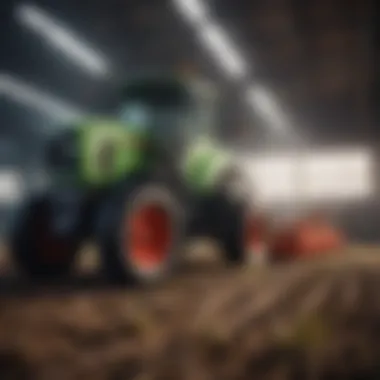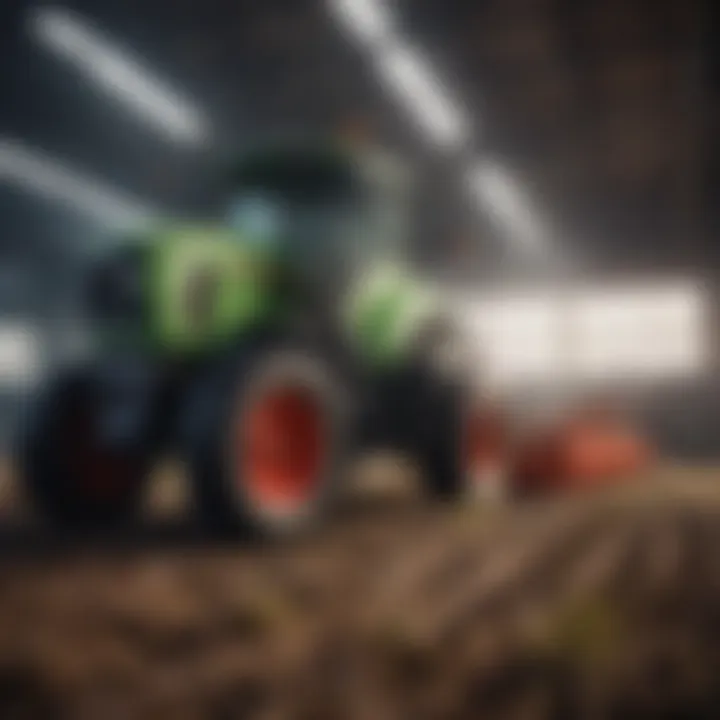Effective Cleaning and Sanitizing in Agriculture


Intro
In the realm of agriculture, where the health of crops determines the yield and sustainability of farming practices, effective cleaning and sanitizing are more than just necessary chores; they are pivotal for success. Every farmer knows that maintaining a conducive environment, free from pathogens and harmful contaminants, is essential. However, the concepts of cleaning and sanitizing often get tangled up. Knowing the difference, along with the strategies necessary to implement them, can be the game-changer in any agricultural operation.
Cleaning simply removes dirt and debris, whereas sanitizing involves reducing the number of pathogens. This distinction may seem trivial, but it can have profound effects on both plant health and crop production. Understanding these nuances can empower farmers and horticulturists to adopt best practices tailored to their specific scenarios.
As we push forward in our quest for sustainable agriculture, there's a growing trend toward eco-friendly cleaning solutions, which do not compromise soil health or biodiversity. In this article, we'll unpack key concepts, explore recent innovations, and provide practical applications that can be integrated seamlessly into daily farming routines.
Understanding Cleaning and Sanitizing
In the agricultural realm, the process of cleaning and sanitizing is not merely a matter of aesthetics or routine; it plays a crucial role in sustaining healthy farming practices and ensuring the well-being of crops. Understanding the nuances between cleaning and sanitizing forms the cornerstone of effective agricultural management and is essential for anyone trying to improve both productivity and biosecurity on their farms.
Farmers and horticulturists might often think of these terms as interchangeable, but grasping their distinct differences can be the key to preventing plant diseases and contaminants from wreaking havoc on yields. By establishing a well-defined cleaning and sanitizing protocol, one can not only enhance crop quality but also prolong the lifespan of farming equipment.
Defining Cleaning
Cleaning is primarily concerned with the removal of dirt, debris, and foreign materials from surfaces. This might include mud from shoes, plant residues, or buildup on machinery. Imagine a field after winter—it's often laden with leaves and twigs. Before you can even think about planting, cleaning that field and ensuring any equipment is free from the remnants of the past season is vital.
To clean effectively, using water along with specific cleaning agents can elevate the process. Detergents or soaps are often employed to break down grease and grime, making it easier to wash away unwanted materials. It's like washing your hands thoroughly to remove any lingering germs; the same principle applies here—clean surfaces pave the way for effective sanitization.
Defining Sanitizing
Sanitizing takes the process a step further. It involves the application of chemical agents that significantly reduce the number of pathogenic microorganisms on a cleaned surface to a safe level. This is where the magic happens—simply cleaning surfaces doesn’t kill harmful bacteria or fungi; it merely clears the decks.
The key to successful sanitization often lies in the choice of sanitizing agent. There are many on the market, from chlorine-based options to alcohol solutions, each with its unique properties and effectiveness against certain pathogens. Knowing when and how to apply these agents is just as crucial as knowing how to clean things properly. Think of it like putting on sunscreen after washing up at the beach—you wouldn't want to forget that last step not to get burnt!
Key Differences Between Cleaning and Sanitizing
Distinguishing between cleaning and sanitizing can truly be a game-changer in agricultural practices. Here are the foundational differences:
- Purpose:
Cleaning is about removing dirt and impurities, while sanitizing is focused on reducing the microorganisms to safe levels. - Frequency:
Generally, cleaning might be performed more frequently than sanitizing. Daily chores might involve sweeping and removing debris, while sanitizing may occur on a weekly or bi-weekly basis. - Process:
Cleaning requires physical effort and can be accomplished with minimal chemical agents, while sanitizing heavily relies on specific chemical solutions you wouldn’t use in cleaning alone. - Result:
The end result of cleaning is a visually appealing surface, while sanitizing provides the assurance that surfaces are microbiologically safe.
Understanding these differences can equip farmers and agricultural professionals to make informed decisions, ultimately safeguarding crop health and improving farm productivity. The link between cleanliness and successful crop yields cannot be overstated, and by prioritizing both cleaning and sanitization, individuals can set themselves up for success in their agricultural pursuits.
The Importance of Cleaning in Agriculture
Cleaning in agriculture is not just a matter of aesthetics; it’s a cornerstone of sustainable farming practices. The cleanliness and sanitation of farming equipment, tools, and environments directly influence crop health and yield. Effective cleaning keeps diseases at bay, improves the quality of produce, and extends the life of the equipment, which ultimately benefits the farmer’s bottom line. This essential practice embodies an understanding that a healthy farm begins with a clean slate.
Preventing Disease Spread
One of the foremost reasons for rigorous cleaning in agricultural settings is the prevention of disease spread. Pathogens such as bacteria, fungi, and viruses can hitch a ride on dirty equipment or contaminated surfaces. These microorganisms can wreak havoc, leading to devastating plant infections.
Farmers must be vigilant. Regularly cleaning tools and spaces not only eliminates dirt and residue but also helps disrupt the lifecycle of harmful pathogens. For instance, when greenhouse surfaces are routinely sanitized, it minimizes the risk of diseases like powdery mildew and root rot from taking hold in crops.
A simple practice can be as effective as using hot water and soap in a cleaning solution and following up with an appropriate sanitizer. This action reduces the microbial load significantly. Remember that it is better to be proactive than reactive. As they say, an ounce of prevention is worth a pound of cure.
Enhancing Crop Quality
Cleanliness directly correlates with crop quality; it’s not merely about disease prevention. Take, for example, the harvesting of fruits and vegetables. If tools used for cutting and gathering crops are not properly cleaned, residuals from previous harvests can transfer to fresh produce. This cross-contamination can result in inferior quality and even spoilage.
Additionally, clean fields lead to healthier plants, resulting in better yields. When plants grow in a clean environment, they are less likely to compete for nutrients with weeds fostered by poor maintenance practices. This ensures that crops receive everything they need to thrive.
Moreover, clean produce not only looks appealing but can significantly impact marketability. When consumers see well-maintained food, they're more inclined to purchase it—after all, who wouldn’t want to buy a shiny, fresh apple over a dull, dirty one?
Improving Equipment Longevity
Neglecting to clean farm equipment is a surefire way to invite premature wear and tear. Dirt, grime, and residue can lead to corrosion and reduce the efficiency of machines. For instance, irrigation systems clogged with dirt won't deliver water effectively, which can impact entire crop sections.
Establishing a routine to clean equipment after use or at regular intervals can drastically increase its lifespan. Equipment manufacturers often suggest maintenance schedules that include cleaning because they understand that it not only keeps machinery functioning well but also safeguards investments in the long term.
Shiny tools are not just for show; they represent reliability and durability. By prioritizing cleaning, farmers can avoid costly repairs and replacements down the line, thus improving their operational efficiency.


"A clean farm is a happy farm—happy crops, happy equipment, happy wallet."
Therefore, the importance of cleaning in agriculture cannot be overstated. It acts as a protective measure against diseases, enhances the quality of produce, and ensures the longevity of tools and machinery—all factors that contribute to the health and productivity of a farming operation.
Best Practices for Cleaning
Effective cleaning isn’t just a chore; it's a cornerstone for success in agriculture. Getting this right helps keep your farming operation healthy and productive. Beyond the basics of removing dirt and grime, it’s essential to foster an environment that actively prevents pests and pathogens from hijacking your crops. This section will walk through critical best practices for cleaning, aiming to equip farmers and horticulture enthusiasts with knowledge that's both practical and actionable.
Developing a Cleaning Schedule
Having a well-crafted cleaning schedule is akin to having a solid foundation for a house; without it, everything can crumble. Creating a routine for cleaning tasks can significantly ease the workload while ensuring no task is neglected. This can involve daily, weekly, and seasonal schedules tailored to your specific agricultural needs.
- Assess Your Environment: Start by evaluating the specific areas that require more thorough cleaning, such as greenhouses, equipment, or storage areas.
- Allocate Responsibilities: If you work with a team, designate cleaning tasks based on individual strengths and availability to ensure all hands are on deck.
- Set Reminders: Utilize calendars or mobile applications to set reminders; keeping your schedule visible can help maintain accountability.
Ultimately, consistency is key. Regular cleaning prevents buildup that could lead to greater issues down the line.
Using Appropriate Cleaning Agents
The right cleaning agent is like a chef having the perfect ingredient. A cleaning agent depends on what you're dealing with, whether it’s soil, animal waste, or plant residue. Here are factors to consider when choosing these agents:
- Know Your Needs: Different cleaning agents work best for varying types of dirt and surfaces. For instance, enzymatic cleaners can break down organic matter effectively, while bleach may be suitable for disinfecting surfaces.
- Eco-Friendliness: Select biodegradable or organic cleaning products whenever possible. This is not only better for the environment but also for the health of the soil and crops.
- Concentration Matters: Use the correct dilution rates. Too strong can harm surfaces and ecosystems, while too weak might not eliminate the pathogens you want to eradicate.
Investing in the right cleaning agents ensures that you are not just cleaning, but also sanitizing effectively.
Techniques for Effective Cleaning
Cleaning effectively requires more than just elbow grease. Apply systematic techniques to get the job done right:
- From the Top Down: Always start from the highest point and work your way down. This ensures that dirt and debris don’t fall onto already cleaned surfaces.
- Agitate: Whether you are scrubbing by hand or using a power washer, agitation helps lift dirt. More stubborn residues may require being given a second pass after letting the cleaning solution dwell for a while.
- Thorough Rinsing: After applying cleaning agents, rinse surfaces thoroughly. Residue can lead to adverse reactions or diminish the effectiveness of subsequent sanitization efforts.
These techniques help maximize the efficiency of your cleaning efforts and can save time in the long run.
Cleaning Tools and Supplies
The tools you employ to clean can make or break your cleaning routine. High-quality supplies not only improve efficiency but also enhance the effectiveness of your cleaning efforts. When considering your toolkit, take note of the following:
- Invest in Quality Tools: Whether it's scrub brushes, mops, or pressure washers, durability matters. Good tools stand the test of time and consistently deliver results.
- Organizational Strategies: Keep all cleaning supplies in one central location that’s easily accessible. This minimizes downtime when searching for items, enabling you to streamline the entire cleaning process.
- Replacement and Maintenance: Regularly inspect and replace worn-out tools. A frayed mop or a broken squeegee will make cleaning less effective and more frustrating.
Incorporating the right tools makes the process smoother, leading to cleaner workspaces and healthier crops.
“You can’t make a silk purse out of a sow’s ear.” Proper cleaning practices are essential for producing high-quality crops. Start with a solid foundation by establishing best practices for cleaning in your agricultural setting.
Understanding Sanitizing in Depth
Sanitizing is a vital aspect of agricultural practices, serving as the undercurrent that keeps the systems running smoothly and healthily. It plays a crucial role not only in maintaining hygiene but also in safeguarding crops and livestock from harmful pathogens. Understanding how to sanitize effectively boosts confidence among farmers and horticultural enthusiasts alike. When sanitation is prioritized, it helps minimize disease spread, thereby enhancing productivity and sustainability in farming operations.
When to Sanitize
Timing is of the essence when it comes to sanitizing. It’s imperative to have a clear understanding of those pivotal moments that require sanitization. These include:
- After Cleaning: Ensuring surfaces are sanitized after a thorough clean removes any remaining microorganisms, thereby enforcing a second barrier against contamination.
- Before Planting: New fields or planting areas should be sanitized to prevent pathogens that could compromise young and vulnerable plants.
- Seasonally: During transitions between growing seasons, sanitizing helps eliminate pest populations or diseases that may linger.
- Post-Harvest: After harvesting, sanitizing tools and equipment is essential to interdict any pathogens before they can affect the next crop cycle.
Recognizing these key moments allows for a more strategic approach to sanitation, giving producers the ability to shield their crops effectively.
Types of Sanitizers
Not all sanitizers are created equal. Various types of sanitizers suit different contexts in agriculture, each with its unique mechanisms and applications:
- Chlorine-based Sanitizers: Commonly used due to their effectiveness in killing bacteria and viruses. They are particularly useful in water applications.
- Quaternary Ammonium Compounds (Quats): These are popular for surface disinfecting. They’re less corrosive than chlorine and leave a residual effect on surfaces, which is favorable in preventing future contamination.
- Hydrogen Peroxide: An excellent alternative as it breaks down into water and oxygen, making it environmentally friendly.
- Organic Acid Sanitizers: These natural solutions, like acetic acid or citric acid, provide effective antimicrobial properties with a lower environmental impact.
Choosing the right sanitizer depends on factors like cost, availability, toxicity, and environmental safety, which are vital for sustainable practices.


Application Methods for Sanitizers
Applying sanitizers correctly is just as important as selecting the right product. Here are effective methods to consider:
- Spraying: This method allows for an even distribution, ensuring all areas are covered. It’s best for larger surfaces and equipment.
- Wiping: For smaller surfaces or tools, using a cloth soaked in sanitizer can enhance the direct contact time, often leading to better results.
- Dipping: Suitable for smaller objects like hand tools or harvest containers, dipping ensures thorough exposure.
- Fogging: This advanced technique disperses sanitizer as fog, which penetrates hard-to-reach areas, ideal for enclosed spaces.
Proper application methods ensure that sanitizers work effectively, preventing the spread of contaminants and upholding a high standard of hygiene in agricultural settings.
In summary, understanding sanitizing in depth entails knowing when to sanitize, what types to use, and how to apply them effectively. Each aspect plays a role in creating a safe environment for crops, livestock, and farm personnel.
Cleaning and Sanitizing in Different Agricultural Contexts
Cleaning and sanitizing are not one-size-fits-all processes, especially in agriculture. Each environment poses unique challenges that require tailored approaches to ensure efficacy in maintaining overall health and productivity. Farmers need to understand that the approach to cleaning and sanitizing varies significantly between settings, such as greenhouses, outdoor fields, and equipment. By adapting techniques to specific contexts, the likelihood of pathogen spread diminishes, thus protecting crop yield and quality.
Greenhouses
In the controlled environment of a greenhouse, the atmosphere can quickly become a breeding ground for plant diseases if not properly managed. The limited space and high humidity levels make it vital to regularly clean surfaces, tools, and equipment.
- Benefits of Cleaning in Greenhouses: Proper cleaning helps in removing not just visible dirt but also residue where pests may breed. This is especially crucial against diseases like powdery mildew or botrytis, which can flourish in moist conditions.
- Considerations: Water types, pH levels of cleaning solutions, and the choice of materials used (like cloths or sponges) must be considered, as some may introduce contaminants rather than eliminate them. Additionally, it’s essential to sanitize after cleaning with effecitve agents that don't harm the plants or the environment.
"A clean greenhouse is like a clean slate; it lays the foundation for healthy growth."
Outdoor Fields
Cleaning outdoor fields presents a different set of challenges compared to greenhouses. The ground is exposed to environmental elements, and the risk of soil-borne pathogens is significantly higher.
- Key Practices: Implementing crop rotation and maintaining cleanliness around equipment and pathways can play a vital role in preventing the transfer of contaminants. Farmers should also be mindful of cleaning their boots before entering fields, as soil can carry harmful microorganisms.
- Benefits of Regular Monitoring: By routinely checking for signs of disease and promptly addressing any issues, farmers can safeguard their crops and ensure that their fields remain productive.
Farm Equipment
Farm equipment serves as a conduit for dirt and pathogens, playing a critical role in the overall biosecurity of the operation.
- Cleaning Techniques: Regular pressure washing of machinery used in the fields, such as tractors and harvesters, is necessary to eliminate soil and prevent the spread of pathogens. Pay attention to parts of the equipment that may hold residues, like undercarriages and filters.
- Considerations for Sustainability: Opting for biodegradable cleaning agents not only protects the environment but also maintains soil health, promoting healthier crops down the line.
Harvesting Tools
Harvesting tools, from scissors to trowels, are frequently in contact with both soil and crops. Their cleanliness directly impacts crop quality during post-harvest handling.
- Sanitization Practices: After each use, tools should be thoroughly cleaned and sanitized. This can involve submerging tools in a sanitizing solution or spraying them with a disinfectant. Conversely, it is equally important to ensure that drying off tools does not introduce new contaminants.
- Benefits: Clean harvesting tools help in reducing the risk of spoilage and disease transmission during post-harvest processing, directly affecting marketability and shelf life.
Through diligent cleaning and sanitizing adapted to each context in agriculture, crops can flourish, and farmers can ensure their hard work pays off. It’s not just a chore; it’s a vital practice for both farm health and environmental sustainability.
Sustainable Practices in Cleaning and Sanitizing
In the quest for effective cleaning and sanitizing, sustainability can sometimes feel like a buzzword thrown around without much consideration for its real-world impact. However, when it comes to agriculture, embracing sustainable methods isn’t just a fancy option—it’s a necessity. Adopting sustainable practices contributes not only to healthier crops but also to the long-term health of the ecosystem at large.
Environmental Considerations
Farmers face unique challenges when managing land and resources. The application of cleaning agents and sanitizers often raises environmental concerns. Using harsh chemicals can lead to soil degradation, water contamination, and harm to beneficial microorganisms that exist to sustain plant health. Hence, being mindful of
everything from runoff to the long-term effects of chemical use is crucial.
- Water management becomes an essential factor. Proper cleaning processes should require less water without compromising quality.
- Soil health must also be preserved. Techniques like bioremediation that use living organisms to clean up contaminated environments can render soil better off overall.
"Not all cleaning agents are created equal. Understanding their environmental footprint is as vital as knowing how to use them."
Choosing Eco-Friendly Products
The market’s breadth for eco-friendly products appears overwhelming, yet it also provides a golden opportunity for farmers to transition toward sustainable practices. Selecting biodegradable and non-toxic cleaning products not only safeguards the environment but also enhances safety for farmworkers and consumers alike.
When choosing, look for:


- Certifications: Look for products that are certified organic, eco-labels, or comply with sustainability standards (like the EPA’s Safer Choice).
- Concentration: Highly concentrated products require lesser amounts for the same cleaning effect, thereby minimizing packaging and transport-related emissions.
- Multi-use Solutions: Select products that can perform multiple functions, reducing the need for a plethora of different cleaners.
Focusing on eco-friendly options shows a commitment to responsible farming and can also serve to enhance your farm’s reputation among increasingly conscientious consumers.
Integrating Biodiversity Principles
Biodiversity can often seem like a distant concern for farmers knee-deep in day-to-day operations. Yet, it plays a pivotal role in sustainable cleaning and sanitizing practices. The relationship between healthy ecosystems and effective agricultural practices is a delicate balance.
- Utilizing native plant extracts: Certain plants possess natural antimicrobial properties. For example, extracts from lemon balm and eucalyptus can effectively clean and sanitize without harming beneficial insects or soil health.
- Diverse cropping systems: Promoting biodiversity on the farm can help reduce pathogens naturally. Healthier ecosystems often yield crops that are less susceptible to pests and diseases, decreasing the overall need for aggressive chemical treatments.
- Participation in Local Ecosystems: Engage with community practices that foster biodiversity. Collaborate with local agri-environment schemes that promote practices beneficial to both agriculture and natural habitats.
Measuring Effectiveness
Measuring effectiveness in cleaning and sanitizing processes is crucial to ensure that agricultural practices are yielding the desired outcomes. It is not just about ensuring cleanliness but rather assessing the impact of these efforts on crop health and disease prevention. By quantifying results, farmers can hone their methods, utilize resources more effectively, and ultimately tend to healthier crops.
Monitoring Cleaning Outcomes
Monitoring cleaning outcomes involves meticulously assessing the results of cleaning operations. This step is paramount, as it allows farmers to determine whether their cleaning protocols are working adequately. Different methods can be employed to monitor outcomes. For instance:
- Visual inspections: Regularly inspecting surfaces for dirt or organic residue can provide immediate feedback on cleaning efficacy.
- Microbial testing: Collecting samples and analyzing them for pathogens or contaminants can help quantify the effectiveness of sanitization efforts.
- Record keeping: Keeping a log of cleaning activities, including dates and conditions, allows for the identification of patterns that may impact effectiveness.
Each of these methods can steer future cleaning and sanitizing decisions. Seeing clear results, or a lack thereof, can help farmers adjust their approaches as needed. For instance, if microbial tests reveal continual contamination, it may indicate a need to change cleaning agents or techniques.
Feedback Mechanisms
Implementing feedback mechanisms is a strategic move in maintaining cleaning and sanitizing effectiveness. Feedback can come from various sources:
- Employee feedback: Those who are directly involved in cleaning operations can provide insights into what works or where challenges lie. They might comment on the usability of cleaning tools or the efficacy of certain products.
- Consumer feedback: Ultimately, results are reflected in the quality of the produce. Customer complaints about contamination or poor quality can guide corrective measures.
- Data analysis: Beyond simple observations, data collected from microbial testing and visual inspections can be aggregated and analyzed to uncover trends. This analysis can be invaluable in identifying root causes of recurring issues.
Regular feedback helps fine-tune cleaning strategies, ensuring they are both practical and effective.
Through these mechanisms, farmers can make informed decisions that drive ongoing improvements in cleaning practices. As practices become more effective, there is not only better protection against pathogens but also an enhancement in crop quality and longevity.
Challenges in Cleaning and Sanitizing
In the agricultural sector, cleaning and sanitizing are more than just mundane tasks; they are critical to ensuring healthy and high-yielding crops. Yet, these vital practices face a myriad of challenges that can deter even the most diligent practitioners. Understanding these hurdles is essential for farmers and agricultural enthusiasts who aim to optimize their methods while protecting their crops from pathogens. This section delves into the common pitfalls and the resistance to change that often complicate these processes.
Common Pitfalls
Cleaning and sanitizing might appear straightforward, but they come with their fair share of challenges that can undermine effectiveness. To mitigate these pitfalls, let's explore some key mistakes that are often made:
- Inadequate Training: One must recognize that cleaning isn’t simply a physical act, but a skill that requires training and knowledge. Often, employees may not fully understand the importance of specific procedures, leading to lapses in protocol.
- Using Wrong Products: Selecting inappropriate cleaning agents can spell disaster. Some products may not adequately remove grime, while others might not be compatible with the surfaces or materials in use, leading to surface damage or ineffective sanitization.
- Overlooking Hard-to-Reach Areas: It’s easy to clean what’s visible, but neglecting hidden spaces—like under machinery or inside filters—can allow contaminants to thrive. These ignored locations become potential breeding grounds for pathogens.
- Setting Unrealistic Schedules: Time management is crucial. Rushing the cleaning process to focus on production can lead to inadequate sanitizing, creating fertile ground for pests and diseases.
"Neglecting the little things is what turns minor problems into major disasters, especially in agriculture."
Overcoming Resistance to Change
Resistance to change is another significant obstacle facing cleaning and sanitizing efforts within agriculture. Change can be daunting, particularly in a field where traditions have run deep for generations. Here are some strategies to encourage a shift in mindset:
- Education and Awareness: Providing comprehensive training sessions that emphasize the benefits of modern cleaning techniques can build trust. When individuals understand how effective practices can improve overall yields, they might be more willing to adapt.
- Pilot Programs: Implementing small-scale trials of new methods allows workers to witness the benefits firsthand. Once they see positive results, it fosters a willingness to adopt these changes on a larger scale.
- Incentives: Offering rewards or recognitions for exceptional cleaning and sanitizing efforts can motivate teams to embrace new techniques wholeheartedly.
- Engagement: Create a dialogue about the importance of cleaning, actively involving employees in discussions about practices and improvements. Such engagement fosters a sense of ownership, reducing resistance to change.
Future Trends in Cleaning and Sanitizing Practices
The agricultural landscape is constantly in a flux, driven by innovation and the pressing need for sustainability. In the realm of cleaning and sanitizing, this evolution cannot be understated. The future trends are likely to stem from a mix of technological advancements, changes in policies, and the ever-growing demand for sustainable practices. Addressing these trends not only provides insight into what lies ahead but also helps producers stay ahead of the curve, ensuring quality and safety in food production.
Technological Advancements
As we move forward, technology is shaping every facet of farming, and cleaning and sanitizing are no exceptions. Automation and digitalization are paramount to enhancing efficiency in agricultural practices. Consider the introduction of robotic cleaners in large agricultural facilities. These robots can tackle vast areas, ensuring thorough cleaning with minimal human intervention. This leaves workers free to focus on more nuanced tasks that require their expertise.
Moreover, the rise of sensors and IoT (Internet of Things) in agriculture allows for precise cleaning schedules based on real-time data. For instance, sensors can detect contaminant levels and automatically trigger a cleaning cycle when necessary. This targeted approach not only saves time but also resources, as cleaning occurs only when needed rather than on a predetermined schedule.
With advancements in materials, cleaning agents themselves are also evolving. Biodegradable and non-toxic substances are becoming commonplace, pushing traditional, harsh chemicals to the background. These innovative agents can be just as effective in sanitizing without leaving behind harmful residues that could affect crop health.
Policy Implications
As trends in cleaning and sanitizing practices progress, policymakers must stay in step. Governing bodies are now focusing more on food safety regulations and stringent cleanliness standards. Often, compliance with these regulations can be the difference between gaining customer trust and suffering reputational loss. Benchmarking these regulations with emerging practices ensures that farmers are not just compliant but also setting new standards.
New policies may encourage the use of eco-friendly products, promoting their benefits not only from a health perspective but also from an environmental standpoint. They aim to foster practices that mitigate ecological footprints—this is important, as consumers increasingly demand accountability in how food is cleaned and produced.
It's also crucial that farmers engage in conversations with policymakers. By voicing the unique challenges they face, agricultural workers can influence the formulation of regulations that are practical, realistic, and beneficial for the farming community.















